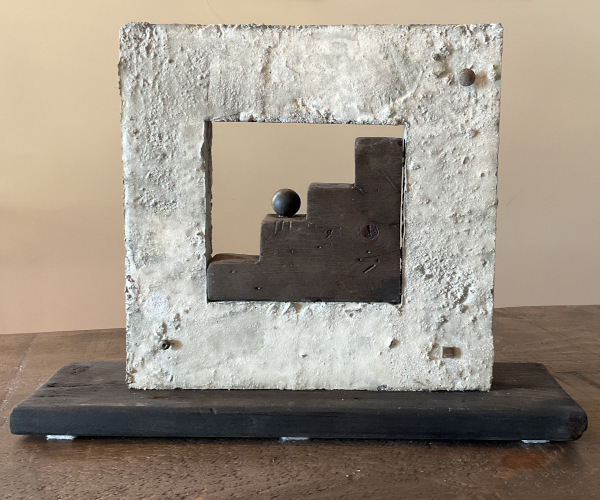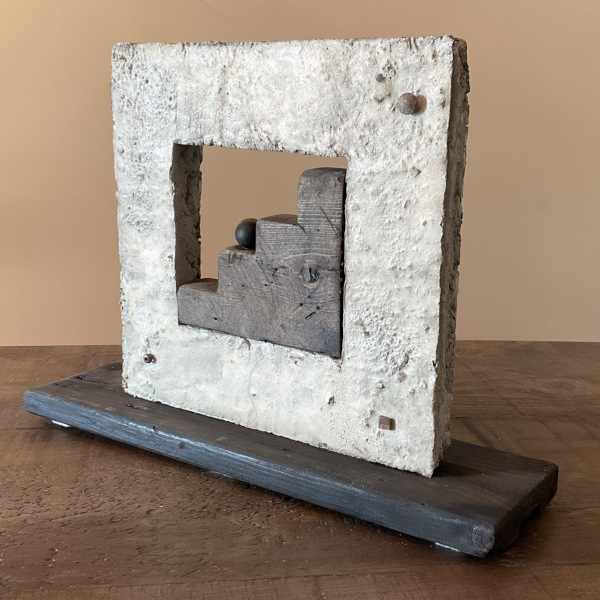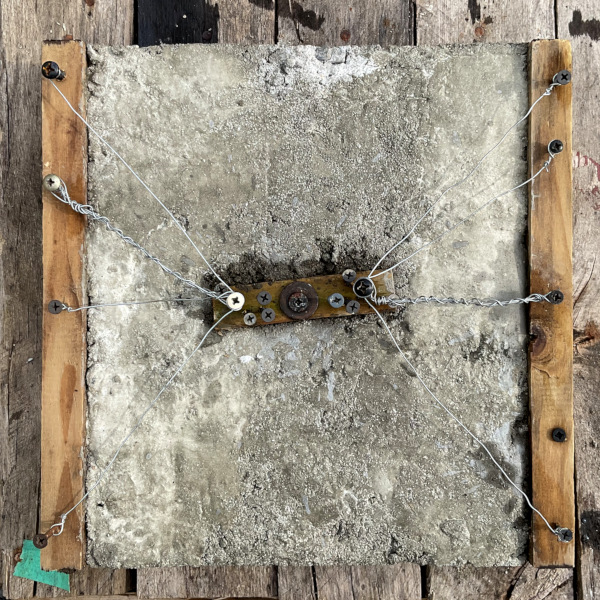Data Sculptures



“Intelligence Staircase v3.2 (Last Chance on the Stairway (Data Sculpture #6))”, 2025. Mixed Media (Wood, Cement, and Screws), ~13 by 15 by 5 Inches.
The Intelligence Staircase is a metaphor, developed by Tim Urban and now used by many other AI thinkers and safety researchers, to examine and investigate the issues around cognitive disparity. Specifically, how we will deal with an intelligence or superintelligence (of any origin) that is as relatively distant from us, cognitively, as we are from, let’s say the lowland gorilla, or even more so. Lowland gorillas are, depending on the (arbitrary) size of the steps, probably pretty close to us on the conceptual staircase. We can speak with lowland gorillas to a limited extent. Few of us will put in the effort to do so, and we don’t generally look to them for philosophical discussions. And while I think it is safe to say that everyone likes lowland gorillas, and few people wish to cause them harm, they are critically endangered. If we take another step or two down the staircase, to say chickens, our communications tend to be fairly one sided. Another few steps down, to, for example, earthworms, and they don’t even really register with most people, most of the time. One of the dangers of developing Artificial General Intelligence (AGI) is that it could rapidly, recursively, improve itself. Then it will start climbing the Intelligence Staircase. We may go from being collaborators to, well, something else. Of course, there’s another, longer discussion to have here — that we still lack a clear and consensus definition of intelligence, even as we strive to recreate it.
With this piece, I was continuing to play with the idea of data sculptures, and with cement. Versions 1 and 2 were lost to learning about working with cement, very much an ongoing process. I’m going to try for a version 4, probably half the height, a little deeper, and a little cleaner, although I am enjoying working in the messy abstract. Most of my life, I have avoided abstraction and aimed for direct representation. I loathed modernism in school and felt that Clement Greenberg’s focus on form over function and emphasis on maintaining the integrity of the medium was borderline offensive. I’m not about to become an abstract expressionist, but pushing your personal aesthetic boundaries can be healthy. I had an art teacher who, after watching me toil over small canvases with the finest-tipped brushes I could find, handed me a large piece of plywood and a 3-inch-wide brush, and made me work with that. I recall balking at the time, but it’s a lesson that I try to relearn.
The song quote in the name is the title and lyric of a Duran Duran song. I’m still working on the naming scheme. I haven’t got quite to the point of making the titles of artworks their own poem, short story, or functioning algorithm. Yet. “The naming convention will continue to change until morale improves.”
I’ll close with the following quote from Licklider, from 1960, about the period of time where we are partners with our creations.
“In short, it seems worthwhile to avoid argument with (other) enthusiasts for artificial intelligence by conceding dominance in the distant future of cerebration to machines alone. There will nevertheless be a fairly long interim during which the main intellectual advances will be made by men and computers working together in intimate association. A multidisciplinary study group, examining future research and development problems of the Air Force, estimated that it would be 1980 before developments in artificial intelligence make it possible for machines alone to do much thinking or problem solving of military significance. That would leave, say, five years to develop man-computer symbiosis and 15 years to use it. The 15 may be 10 or 500, but those years should be intellectually the most creative and exciting in the history of mankind.”
“Man-Computer Symbiosis”, J. C. R. Licklider, IRE Transactions on Human Factors in Electronics, volume HFE-1, pages 4-11, March 1960.

“Nine Inch Neuron (The Honey Inside Your Hive)”. 2025 Mixed Media (Wood, Cement, Wire, and Screws), 12 by 12 Inches.
Artificial Neural Networks (ANNs) are algorithmic models inspired by biological neurons. Each artificial neuron takes in a series of inputs, applies weights to those inputs, and then passes the result through an activation function to produce an output. The strength (or weight) of the connections between neurons determines how signals flow through the network. During training, these weights are adjusted through feedback (often via a process called backpropagation), allowing the network to learn tasks such as pattern recognition or decision-making.
This piece was mostly accidental. I have been working on building boards and doing preparatory work for my current project (https://datasculptures.com/wip.html), and I found myself with a little time, some cement, and the various detritus that tends to accumulate on workbenches. I had been planning another piece (based on the intelligence staircase), but that went sideways—and then this happened. I imagine it as a wall hanging, though that may depend on how confident I get about the structural integrity of my picture rails.
The title is drawn from Nine Inch Nails’ Closer. The track happened to be playing as I worked, and the resulting form felt equally at home as a neuron diagram or the cover art of an industrial album. Right now, the piece is sitting outdoors, waiting for the rain to leave its own feedback on the piece.
“Who Made Who (Data Sculpture #3)”, 2025, Painted Wood, 22 by 12 by 14 Inches.
Support Vector Machines (SVM) are supervised machine learning algorithms primarily used for classification tasks. Simply put, an SVM finds the boundary that best separates data points of different classes, so points from Group A are on one side of the plane and points from Group B are on the other.
In this sculpture, the data points are the smallest spheres, separated by a plane that is described by the larger spheres. One of the smaller points is distinctly distant from the others, an outlier. In data science, outliers are sometimes removed from datasets to create models which are more accurate for the majority of the data.
I have found that the most interesting places are liminal, the border places where domains, ideas, disciplines meet. As I am slowly learning the ins and outs of machine learning and artificial intelligence, I am trying to reinforce new mental models with old. And along the way, hopefully I’ll find inspiration.
“A Function of Loss (Data Doesn’t Suffer #2)”. 2025 Mixed Media (Wood, Wire, Glue, Nails, and Paint), ~18 by 12 Inches.
The purpose of a loss function is to measure how far a model’s predictions are from the truth—a map that shows how wrong the model is at any given point. This distance guides how much and how fast the model must change to become more accurate. In an idealized world, the graph of a loss function resembles a smooth bowl or a champagne flute: the steep walls represent regions where the model performs poorly, and larger adjustments are needed; the flatter bottom is where the model is nearer to truth, and changes should be smaller and more cautious. Move too fast here, and you will overshoot the goal, passing over the lowest valley and landing on the opposite slope of error.
But in the real world, the geography of loss is not simple or smooth. The landscape is jagged, full of false peaks and deceptive valleys that can lead the model into settling for something that looks like success but isn’t.
In this piece I tried to maintain the integrity of the state of the materials. The wood is worn, rotting, and stained; the nails and wires are bent and rusty in places. The title/quote “Data doesn’t suffer” is from Nick Cave, when he was confronted by song lyrics a fan had created using ChatGPT in his style (The Red Hand Files #218, https://www.theredhandfiles.com/chat-gpt-what-do-you-think/).

"Model Model (Data Doesn't Suffer #1)". 2025, Painted Wood. Approximately 8 by 8 by 1 Inches.
The idea behind this was to make a 3D model of a simplified drawing of an artificial neural network. A sculptural sketch of the kind of diagram that might be scrawled on a white board to explain how an artificial intelligence model learns.
“Data Sculpture (Nude, Reclined)”. 2024. Mixed Media (Wood), 12 by 6 by 12 Inches.
This was another piece playing around with the idea of communicating binary (and ASCII) as part of a sculpture. The larger cubes represent 1’s, the smaller, 0’s, so the piece spells the word “NUDE” ("N" in binary (ASCII) is 01001110, etc.), and is turned on its side, therefore, “reclined.” The rounded piece, and the base are minimally carved, and refers back to “odalisque” paintings, a genre which was popular a couple of centuries ago in Western art. The intention of the was also to add a limited and abstracted level of representationalism, to make it more than just a 3D, binary-encoded, concrete poem. Sort of an aesthetic flourish to the pun.
“IT Repair Manual of Last Resort”, ~2009, Mixed Media (Egg Tempera on Book), 8 by 6 Inches.
“Portrait of Saint Turing”, 2010, Egg Tempera on Panel, 11 by 9 Inches.
“Looking For Satellites (Portrait of Saint Turing)”, 2023, Acrylic on Paper, 6 by 6 Inches.
“Icon of Saint Turing”, 2025, Acrylic on Wood, 9 by 11 Inches.
“Saint Turing (Fortunate Sons#4)”, 2024, Mixed Media on Paper, 18 by 12 Inches.

